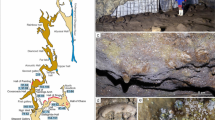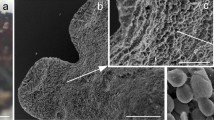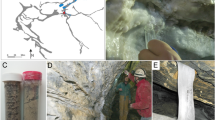Abstract
Caves offer a stable and protected environment from harsh and changing outside prevailing conditions. Hence, they represent an interesting habitat for studying life in extreme environments. Here, we report the presence of a member of the ancient eukaryote red algae Cyanidium group in a coastal cave of the hyperarid Atacama Desert. This microorganism was found to form a seemingly monospecific biofilm growing under extremely low photon flux levels. Our work suggests that this species, Cyanidium sp. Atacama, is a new member of a recently proposed novel monophyletic lineage of mesophilic “cave” Cyanidium sp., distinct from the remaining three other lineages which are all thermo-acidophilic. The cave described in this work may represent an evolutionary island for life in the midst of the Atacama Desert.







Similar content being viewed by others
References
Albertano P, Ciniglia C, Pinto G, Pollio A (2000) The taxonomic position of Cyanidium, Cyanidioschyzon and Galdieria: an update. Hydrobiologia 433:137–143
Antonopoulou S, Oikonomou A, Karantonis HC, Fragopoulou E, Pantazidou A (2002) Isolation and structural elucidation of biologically active phospholipids from Scytonema julianum (Cyanobacteria). Biochem J 367(Pt 1):287–293
Antonopoulou S, Karantonis HC, Nomikos T, Oikonomou A, Fragopoulou E, Pantazidou A (2005) Bioactive polar lipids from Chroococcidiopsis sp. (Cyanobacteria). Comp Biochem Physiol Part B Biochem Mol Biol 142:269–282
Bao H, Gu B (2004) Natural perchlorate has a unique oxygen isotope signature. Environ Sci Technol 38:5073–5077
Barr TC Jr (1968) Cave ecology and the evolution of troglobites. Evol Biol 2:35–102
Barton H, Northup D (2007) Geomicrobiology in cave environments: past, current and future perspectives. J Caves Karst Stud 69:163–178
Bellezza S, Albertano P, de Philippis R, Paradossi G (2006) Exopolysaccharides of two cyanobacterial strains from Roman Hypogea. Geomicrobiol. J 23(5):301–310
Boston PJ (1999) The search for extremophiles on Earth and “beyond”: what is extreme here may be just business-as-usual elsewhere. Ad Astra 11(1):40–44
Ciniglia C, Yoon HS, Pollio A, Pinto G, Bhattacharya D (2004) Hidden biodiversity of the extremophilic Cyanidiales red algae. Mol Ecol 13(7):1827–1838
Cockell CS, McKay CP, Warren-Rhodes K, Horneck G (2008) Ultraviolet radiation-induced limitation to epilithic microbial growth in arid deserts-dosimetric experiments in the hyperarid core of the Atacama Desert. J Photochem Photobiol B 90(2):79–87
Doemel WN, Brock TD (1970) The upper temperature limit of Cyanidium caldarium. Arch Mikrobiol 72(4):326–332
Dose K, Bieger-Dose A, Ernst B, Feister U, Gómez-Silva B, Klein A, Risi S, Stridde C (2001) Survival of microorganisms under the extreme conditions of the Atacama Desert. Orig Life Evol Biosph 31(3):287–303
Ellery A, Kolb C, Lammer H, Parnell J, Edwards H, Richter L, Patel M, Romstedt J, Dickensheets D, Steele A, Cockell C (2003) Astrobiological instrumentation for Mars—the only way is down. Int J Audiol 1:365–380
Faimon J, Telcla J, Kubeováb S, Zimákc J (2003) Environmentally acceptable effect of hydrogen peroxide on cave “lamp-flora”, calcite speleothems and limestones. Environ Pollut 122(3):417–422
Ferris MJ, Sheehan KB, Kühl M, Cooksey K, Wigglesworth-Cooksey B, Harvey R, Henson JM (2005) Algal species and light microenvironment in a low-pH, geothermal microbial mat community. Appl Environ Microbiol 71(11):7164–7171
Ford T (1984) A comparative ultrastructural study of Cyanidium caldarium and the unicellular red algae Rhodosorus marinus. Ann Bot 53:285–294
Friedmann I (1964) Progress in the biological exploration of caves and subterranean waters in Israel. Int J Speleol 1:29–33
Glavin DP, Cleaves HJ, Schubert M, Aubrey A, Bada JL (2004) New method for estimating bacterial cell abundances in natural samples by use of sublimation. Appl Environ Microbiol 70(10):5923–5928
Glöckner G, Rosenthal A, Valentin K (2000) The structure and gene repertoire of an ancient red algal plastid genome. J Mol Evol 51(4):382–390
Goguitchaichvili AT, Alva-Valdivia L, Urrutia-Fucugauchi J (2003) Paleomagnetism and Rock-Magnetism of the Jurassic La Negra Formation, Northern Chile: implications for tectonics and volcanic stratigraphy. Int Geol Rev 45(6):563–573
Gontcharov AA, Marin B, Melkonian M (2004) Are combined analyses better than single gene phylogenies? A case study using SSU rDNA and rbcL sequence comparisons in the Zygnematophyceae (Streptophyta). Mol Biol Evol 21(3):612–624
Gorbushina AA (2007) Life on the rocks. Environ Microbiol 9(7):1613–1631
Grin EA, Cabrol NA, Mckay CP (1998) Caves in the Martian Regolith and their significance for exobiology exploration. Abstract. 29th Annual NASA Lunar and Planetary Science Conference, Houston, Texas
Hartley A, Chong G, Houston J, Mather A (2005) 150 million years of climatic stability: evidence from the Atacama Desert, northern Chile. J Geol Soc 162:421–424
Houston J, Hartley AJ (2003) The central Andean west-slope rain shadow and its potential contribution to the origin of hyper-aridity in the Atacama Desert. Int J Climatol 23:1453–1464
Kiessling P, Senchenkova SN, Ramm M, Knirel YA (2005) Structural studies on the exopolysaccharide from Erwinia persicina. Carbohydr Res 340(11):1761–1765
Larkin MA, Blackshields G, Brown NP, Chenna R, McGettigan PA, McWilliam H, Valentin F, Wallace IM, Wilm A, Lopez R, Thompson JD, Gibson TJ, Higgins DG (2007) Clustal W and Clustal X version 2.0. Bioinformatics 23(21):2947–2948
Maier RM, Drees KP, Neilson JW, Henderson DA, Quade J, Betancourt JL (2004) Microbial life in the Atacama Desert. Science 306(5700):1289–1290
McKay CP, Friedmann EI, Gómez-Silva B, Cáceres-Villanueva L, Andersen DT, Landheim R (2003) Temperature and moisture conditions for life in the extreme arid region of the Atacama desert: four years of observations including the El Niño of 1997–1998. Astrobiology 3(2):393–406
Mercer FV, Bogorad L, Mullens R (1962) Studies with Cyanidium caldarium. I. The fine structure and systematic position of the organism. J Cell Biol 13:393–403
Murata N, Takahashi S, Nishiyama Y, Allakhverdiev SI (2007) Photoinhibition of photosystem II under environmental stress. Biochim Biophys Acta 1767(6):414–421
Nadell CD, Xavier JB, Levin SA, Foster KR (2008) The evolution of quorum sensing in bacterial biofilms. PLoS Biol 6(1):e14
Navarro-González R, Rainey FA, Molina P, Bagaley DR, Hollen BJ, de la Rosa J, Small AM, Quinn RC, Grunthaner FJ, Cáceres L, Gomez-Silva B, McKay CP (2003) Mars-like soils in the Atacama Desert, Chile, and the dry limit of microbial life. Science 302:1018–1021
Northup D, Lavoie H (2001) Geomicrobiology of caves: a review. Geomicrobiol J 18:199–222
Nübel U, Garcia-Pichel F, Muyzer G (1997) PCR primers to amplify 16S rRNA genes from cyanobacteria. Appl Environ Microbiol 63(8):3327–3332
Ott FD, Seckbach J (1994) New classification for the genus Cyanidium Geitler 1933. In: Seckbach J (eds) Evolutionary pathways and enigmatic algae: Cyanidium caldarium (Rhodophyta) and related cells. Kluwer Academic, London, pp 145–152
Pinto G (2007) Cyanidiophyceae: looking back–looking forward. In: Seckbach J (ed) Algae and Cyanobacteria in extreme environments. Springer, Heidelberg, pp 387–397
Robba L, Russell SJ, Barker G, Brodie J (2006) Assessing the use of the mitochondrial cox1 marker for use in DNA barcoding of red algae (Rhodophyta). Am J Bot 93:1101–1108
Sarbu SM, Kane TC, Kinkle B (1996) A chemoautotrophically based cave ecosystem. Science 272:1953–1955
Saunders GW, Hommersand M (2004) Assessing red algal supraordinal diversity and taxonomy in the context of contemporary systematic data. Am J Bot 91:1494–1507
Schwabe GH (1936) Über einige Blaualgen aus dem mittleren und südlichen Chile. Verhn Deutsch Wiss Ver Santiago de Chile NF (Valparaiso) 3:113–174
Seckbach J (1994) The first eukaryotic cells—acid hot-spring algae. J Biol Physics 20:335–345
Skelley AM, Scherer JR, Aubrey AD, Grover WH, Ivester RH, Ehrenfreund P, Grunthaner FJ, Bada JL, Mathies RA (2005) Development and evaluation of a microdevice for amino acid biomarker detection and analysis on Mars. Proc Natl Acad Sci U S A 102(4):1041–1046
Smith T, Olson R (2007) A taxonomic survey of lamp flora (Algae and Cyanobacteria) in electrically lit passages within Mammoth Cave National Park, Kentucky. Int J Speleol 36(2):105–114
Toplin JA, Norris TB, Lehr CR, McDermott TR, Castenholz RW (2008) Biogeographic and phylogenetic diversity of thermoacidophilic Cyanidiales in Yellowstone National Park, Japan, and New Zealand. Appl Environ Microbiol 74(9):2822–2833
Vogl C, Badger J, Kearney P, Li M, Clegg M, Jiang T (2003) Probabilistic analysis indicates discordant gene trees in chloroplast evolution. J Mol Evol 56(3):330–340
Walker JJ, Spear JR, Pace NR (2005) Geobiology of a microbial endolithic community in the Yellowstone geothermal environment. Nature 434(7036):1011–1014
Warren-Rhodes KA, Rhodes KL, Pointing SB, Ewing SA, Lacap DC, Gómez-Silva B, Amundson R, Friedmann EI, McKay CP (2006) Hypolithic cyanobacteria, dry limit of photosynthesis, and microbial ecology in the hyperarid Atacama Desert. Microb Ecol 52(3):389–398
Whitaker RJ (2006) Allopatric origins of microbial species. Philos Trans R Soc Lond B Biol Sci 361(1475):1975–1984
Wierzchos J, Ascaso C, McKay CP (2006) Endolithic cyanobacteria in halite rocks from the hyperarid core of the Atacama Desert. Astrobiology 6(3):415–422
Wynne JJ, Titus TN, Chong G (2008) On developing thermal cave detection techniques for Earth, the Moon and Mars. Earth Planet Sci Lett 272:240–250
Xiao S, Knoll AH, Yuan X, Pueschel CM (2004) Phosphatized multicellular algae in the Neoproterozoic Doushantuo Formation, China, and the early evolution of florideophyte red algae. Am J Bot 91(2):214–227
Yin H, Cao L, Xie M, Chen Q, Qiu G, Zhou J, Wu L, Wang D, Liu X (2008) Bacterial diversity based on 16S rRNA and gyrB genes at Yinshan mine, China. Syst Appl Microbiol 31:302–311
Yoon HS, Hackett JD, Pinto G, Bhattacharya D (2002) The single, ancient origin of chromist plastids. Proc Natl Acad Sci USA 99:15507–15512
Yoon HS, Müller KM, Sheath RG, Ott FD, Bhattacharya D (2006) Defining the major lineages of red algae (Rhodophyta). J Phycol 42:482–492
Acknowledgments
This work was supported by the Millennium Institute of Fundamental and Applied Biology (Chile). We also thank the members of Rafael Vicuña’s Laboratory for critical comments and insights which helped to improve this manuscript.
Disclosure Statement
No competing financial interests exist in connection with the submitted manuscript. This applies to all authors of this paper.
Author information
Authors and Affiliations
Corresponding author
Additional information
An erratum to this article can be found at http://dx.doi.org/10.1007/s00248-009-9521-0
Rights and permissions
About this article
Cite this article
Azúa-Bustos, A., González-Silva, C., Mancilla, R.A. et al. Ancient Photosynthetic Eukaryote Biofilms in an Atacama Desert Coastal Cave. Microb Ecol 58, 485–496 (2009). https://doi.org/10.1007/s00248-009-9500-5
Received:
Accepted:
Published:
Issue Date:
DOI: https://doi.org/10.1007/s00248-009-9500-5




